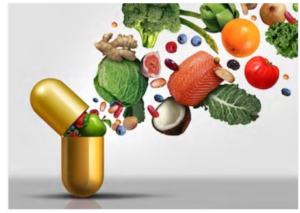by Dr. Cathy Rosenbaum, Rx Integrative Solutions
Holistic Clinical Pharmacist
Certified Health Coach
Certified Fitness Nutrition Coach
SUPPLEMENT DEFINITION
A dietary supplement is a vitamin; a mineral; an herb or other botanical; an amino acid; or a concentrate, metabolite, constituent, extract, or combination of any of the above ingredients.
SUPPLEMENT QUALITY
The FDA is not authorized to approve dietary supplements for safety and effectiveness. Most dietary supplements can be marketed without notifying the FDA (DSHEA Act 1994). To ensure supplement potency and purity, look for proof of independent third-party analytical testing on supplement bottle labels (e.g., see the round quality seals):
- consumerlab.com
- NSF (National Sanitation Foundation) nsf.org
- USP-Verified (U.S. Pharmacopoeia) usp.org
- c-GMP (Good Manufacturing Practice – minimum required by FDA for all dietary supplements)
- Certificate of Analysis (see store’s website, requested from the supplement’s manufacturer)
CLINICAL RESEARCH (SUPPLEMENT INDICATION)
Look for research studies in humans with your same condition/health goal, identifying the exact product, dosing, and length of therapy BEFORE you purchase any dietary supplements
- Visit clinicaltrials.gov (NIH sponsored website for all types of research)
- Do not be misled by marketing hype/confusing supplement claims by famous people
- Follow your doctor’s recommendations on the use of dietary supplements is using the latter instead of prescription medications for your health needs – discuss risk/benefits with your pharmacist (e.g., prescription statins vs red yeast rice for cholesterol lowering)
SUPPLEMENT SAFETY/SIDE EFFECTS
- Work with your pharmacist to manage unwanted effects and/or drug/supplement interactions
- Write to FDA for Freedom of Information post-marking reports on supplement side effects
- Report any unwanted supplement effects to your physician, pharmacist, or directly to the FDA via MedWatch https://www.fda.gov/safety/medwatch-fda-safety-information-and-adverse-event-reporting-program
- Do not take both dietary supplements and prescription medications for the same indication unless directed by your physician (e.g., diabetes mellitus, high cholesterol, high blood pressure)
SUPPLEMENT LABEL
- Carefully read all the instructions for supplement usage, supplement facts, active and inactive ingredient list, and warnings, remembering dietary supplements are regulated by FDA CSFAN as nutrition (not medication) and contain ‘nutritional labels’ (e.g., serving size, not ‘dosing’ like OTC medications)
PROPRIETARY BLEND
- Avoid dietary supplements with ‘proprietary blends’ when manufacturers do not disclose the actual amounts of every active ingredient (amounts considered to be a trade secret)
- Note the proprietary blends are found in multivitamins, supplements for colds/flu, weight loss, body-building protein formulations, and many more
- GLUTEN FREE SUPPLEMENTS
- Prescription and OTC medications are not covered under the FDA’s gluten-free labeling rule whereas dietary supplements are covered. Any foods or supplements that carry the label “gluten-free,” “no gluten,” “free of gluten,” or “without gluten” must contain less than 20 parts per million (ppm) of gluten. For more information, visit the following websites:
ROLE OF THE HOLISTIC CLINICAL PHARMACIST
- Feel free to consult with your holistic clinical pharmacist as an equal partner on your decision-making team to determine which dietary supplements are appropriate for your individual health goals, health conditions, lifestyle choices, and your value system.


